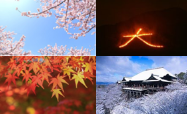Gravity(Attraction) of Kyoto 23 Actual fact
Yoshie Doi


“Connecting the Actual Fact – Change and Challenge.” This slogan was announced on 13th November by the Kyoto Chamber of Commerce and Industry, when it decided to reappoint Horiba as Chairman. It was announced that the city would promote both offensive and defensive urban development while supporting the growth of attractive Kyoto companies, and it feels as though the trend of returning to Kyoto’s roots is accelerating.
As the capital of Kyoto, it was a city of artisans who created the ultimate in authentic craftsmanship, including weaving techniques passed down from the 5th to 6th centuries. There are 74 traditional industries, including Nishijin textiles. Growing up surrounded by such authentic craftsmanship, the people of Kyoto have used traditional techniques to create products that seem beyond human skill.
I am one of those who hope that the traditional techniques of Kyoto will be combined with cutting-edge Japanese technology to create inimitable products that are imbued with the deep passion of the makers. Kyoto is the center of Japanese spirituality, and the climate there is perfect for raising the level of the city.
As the capital of Japan for 1,074 years, Kyoto has continued to be a cultural antenna, and the time has come for it to demonstrate its pride, history, and accumulated cultural wisdom; it is finally Kyoto’s turn.
Kyoto residents who live in the Kyoto Basin spend 365 days a year looking at the mountains. Even in the same season, they are able to keenly sense the changes in nature, enjoying the subtle changes in the colors of the scenery and the changes in the sunlight between morning, noon and evening. They have a sensitive and delicate sense of color, and their tongues remember the umami of lightly seasoned dashi stock.
In Yasunari Kawabata’s “The Ancient Capital,” the scenery of Kyoto as seen from the riverside and from the mountains is beautifully depicted. The setting sun is also beautifully depicted. While being moved by the beauty of each season, I would like to be grateful for the opportunity to live here and burn into my memory the “real thing” that is born from the Kyoto climate, industry, technology, traditional performing arts, festivals, and events.
The end of document
Translated by Masami Otani
